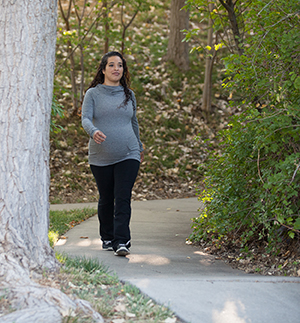What Is Gestational Diabetes?
Gestational diabetes is a type of diabetes that happens during pregnancy. Unlike type 1 diabetes, gestational diabetes is not caused by having too little insulin. Instead, hormones made by your placenta keep your body from using insulin as it should. This is called insulin resistance. Blood sugar (glucose) then builds up in your blood instead of being absorbed by the cells in your body and used for energy.
This can cause high blood sugar and can cause problems for both you and your baby. You can take steps to control your blood sugar. This will help reduce the risks for you and your baby.
Managing gestational diabetes

You need to control your blood sugar while you are pregnant. Your healthcare team will help you make a plan to do this. This plan will include:
-
Eating the right foods. This is the main way to control your blood sugar. You need to eat a variety of healthy foods each day. To help you plan changes in your diet, you will likely work with a registered dietitian (RD). This is an expert on food and nutrition. The dietitian may have you take part in a nutrition program to help you reach your goals.
-
Getting exercise. Your body uses more blood sugar when you exercise. Your healthcare team can help you pick the best kinds of exercise for you.
-
Checking your blood sugar. You will likely need to check your blood sugar at home. You will do this 2 or more times a day. You will likely check your fasting blood sugar and after meal (postprandial) blood sugar. Your healthcare team will teach you how. They will talk with you about your blood sugar goals. Your blood sugar may also be tested every week or so at a clinic. If your blood sugar stays too high, you may need to have insulin shots during your pregnancy.
Risks to your baby
If your blood sugar stays high, your baby is at risk for these problems:
-
Your baby may grow too large. If your blood sugar stays too high, your baby may grow too large. This is called macrosomia. This means a baby is too big for a safe vaginal birth. A large baby may get their shoulder stuck behind the pubic bone during birth. This is called shoulder dystocia. The baby's arms and shoulders could be injured. This may cause permanent arm damage. The baby may also have low oxygen levels (hypoxia) while they are stuck. Hypoxia can lead to cerebral palsy. In rare cases, it can lead to death.
-
Your baby’s organs may not be fully grown at birth. If you have diabetes, your baby may need to be delivered early. This may be because of problems with the pregnancy. Or it may be because of risks to you or your baby. If your baby is delivered early, their lungs may not work well. This is called respiratory distress syndrome. Your baby's liver also may not work normally. And your baby may have yellow color in their skin and eyes (jaundice) after birth.
-
Your baby’s blood sugar may be low after birth. If your blood sugar is too high, your baby makes extra insulin. The baby will keep making extra insulin right after birth. Your baby may need to be treated for low blood sugar.
-
Your baby could be stillborn. This is very rare. But your baby could die before birth if your blood sugar stays high for too long.
Risks to you
If you don’t control your blood sugar, you are more likely to have:
-
High blood pressure. High blood sugar makes you more likely to have high blood pressure during your pregnancy. This is a danger to your health. It could lead to early delivery for your baby.
-
Infections. High blood sugar makes you more likely to have bladder, kidney, and vaginal infections.
-
Trouble breathing. You may feel short of breath. High blood sugar can cause too much fluid around the baby. This is called polyhydramnios. Your abdomen gets big and pushes up on your lungs.
-
Difficult labor. Your delivery may be harder. And your recovery may take longer. If your blood sugar stays too high, your baby may grow too large. A large baby might cause injury to you during birth. Or the baby may have to be delivered by cesarean section (C-section). This means making a cut (incision) in your abdomen and uterus. A C-section is a common risk of gestational diabetes.
Reduce your future risk for type 2 diabetes
Women who have gestational diabetes are at higher risk of type 2 diabetes later. You are also at higher risk for gestational diabetes in your next pregnancy. You can help reduce your risk in these ways:
-
Lose excess weight.
-
Be as active as you can.
-
Eat more fruits and vegetables.
-
Eat fewer processed foods.
-
Get regular blood tests to check for diabetes.
-
Breastfeed your baby.
Who is at risk for gestational diabetes?
You're more at risk if you:
-
Are overweight
-
Have a family history of diabetes
-
Have had a baby who died before birth
-
Had gestational diabetes in the past
-
Are Hispanic, African American, American Indian, South or East Asian, or Pacific Islander
How daily issues affect your health
Many things in your daily life impact your health. This can include transportation, money problems, housing, access to food, and childcare. If you can’t get to medical appointments, you may not receive the care you need. When money is tight, it may be difficult to pay for medicines. And living far from a grocery store can make it hard to buy healthy food.
If you have concerns in any of these or other areas, talk with your healthcare team. They may know of local resources to assist you. Or they may have a staff person who can help.